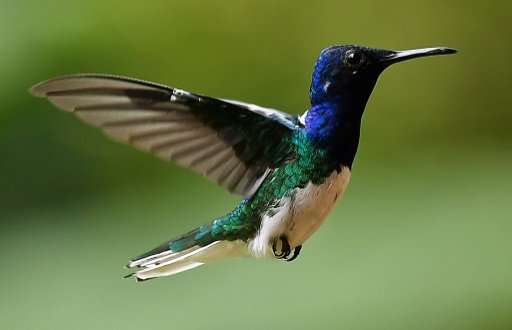Climate change: can hummingbirds take the heat?

Extreme heat sometimes forces hummingbirds to seek shade instead of foraging for food, researchers said Wednesday, warning that global warming could test the tiny birds' capacity to adapt.
With hearts beating more than 1,000 times a minute, hummingbirds need to feed constantly, which means they can ill afford to spend time dodging sunshine, according to a report in the journal Royal Society Open Science.
"They cannot go without eating for even a part of the day," said lead author Donald Powers, a professor at George Fox University in Oregon.
"When temperatures get hot, hummingbirds remove themselves from extended direct exposure to the sun for protection," he told AFP.
"Climate change might make body-temperature maintenance increasingly difficult."
Even their sex lives could suffer—observation during breeding season suggested a disruption of their ability to interact socially.
"It is possible that higher temperature could impact reproduction," Powers said.
The cascading effects of global warming even extend to the plants upon which hummingbirds depend for both sustenance and shade.
If the mostly tropical birds move to higher ground or cooler climes in response to climate change—as many species already have—the flowers from which they draw nectar may no longer be as abundant.
"The problem with rapid shifts in distribution is that the birds can move more quickly than the plants," Powers said.
One of nature's crown jewels, more than 300 species of hummingbirds are found throughout the Western hemisphere.
On average, they consume half their weight in sugar water every day.
Nightime threat
The smallest, the bee hummingbird of Cuba, measures barely six centimetres (2.3 inches) from beak to tail, and could perch comfortably on the tip of a person's little finger.
In the study, Powers and his colleagues used infrared thermal imaging to explore how the birds—which flap their minuscule wings 50 to 200 times a second—evacuate body heat at different temperatures.
They also observed how, in the wild and the lab, hummingbird behaviour changed when things got hot.
"I recall one day last year at one of our Chiricahua Mountain study sites (in Arizona) when temperature exceeded 44 Celsius (111 Fahrenheit) for an extended period, and the birds were clearly struggling," Powers said.
Climate change may pose a threat to hummingbirds at night as well.
To conserve energy, most hummingbirds slip—for at least a couple of hours each night—into a state called torpor, during which their body temperature plunges by 50 to 75 percent.
If nights are warmer than usual, it limits how much energy the birds can save.
"Climate predictions are for nighttime temperatures to warm faster than daytime temperatures," notes Powers, who said he would soon publish a study focusing on this.
To "awaken" from torpor, a hummingbird vibrates its wing muscles—something like shivering—to warm its blood by several degrees a minute.
Hummingbirds are ready for action well before dawn, evidence that the process is governed by their internal, or circadian, clock.
More information: Hovering in the heat: effects of environmental temperature on heat regulation in foraging hummingbirds, Royal Society Open Science, rsos.royalsocietypublishing.or … /10.1098/rsos.171056
Journal information: Royal Society Open Science
© 2017 AFP


















